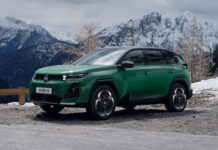Launching a large SUV is a departure from the “cool” image automakers often pursue today. However, even if objectively superior to the CX-60, can the CX-80 truly embody the Mazda spirit? This review examines 4000 miles of experience with Mazda’s new seven-seater, covering its strengths, weaknesses, and overall appeal.
Interior and Design
Mazda’s commitment to refined aesthetics is immediately apparent in the CX-80. The exterior shines with a paint finish among the best in the industry, and the cabin reflects Mazda’s signature individuality. The interior design echoes the familiar feel of the smaller 3 hatchback, featuring a modest digital instrument display and an infotainment touchscreen that prioritizes safety by prompting the use of a large, physical control dial rather than direct touch.
The interior is an upgrade from the earlier 3 model, switching from an all-black scheme to the Takumi trim, which blends cream leather upholstery, light-colored wood accents, and a dashboard material that evokes a comforting familiarity. Mazda offers variety through five trim levels, rather than extensive options, with the Convenience and Driver Assistance Pack at £1950. However, this pack is largely comprised of ADAS features, and it’s generally not worth the cost.
Engine and Performance
The CX-80 is available with a 251bhp 3.3-liter diesel straight-six engine, but the test car features the more contemporary 323bhp PHEV version. Combining a 2.5-liter naturally aspirated four-cylinder petrol engine, a 17.8kWh battery, and an electric motor, the PHEV achieves an official 177mpg, 35g/km of CO2, and a 38-mile electric range, translating to a favorable 13% benefit-in-kind tax rate.
However, the difficulty of home charging proves a real-world limitation. While convenient for those with readily available charging points, the test car’s owner frequently relies on office or family charging, highlighting a common challenge for company car users.
Practicality and Space
The CX-80 delivers on its promise of seven-seat capacity, although practicality shifts considerably with a full complement of passengers. With all seven seats in use, luggage space shrinks to a mere 258 liters (comparable to a Hyundai i10). However, folding the third and second rows expands capacity to 687 liters and ultimately 1971 liters.
The third-row seats feature convenient fabric straps for easy release and retraction. The 60:40 split second-row seats offer a minute to figure out the operating instructions, though they are effective in providing third-row access, folding flat, and sliding on rails.
Cycling Adventure and Interior Durability
A weekend cycling trip exposed both the CX-80’s capabilities and its weaknesses. An unexpectedly jammed through-axle on the test car’s bicycle nearly derailed the outing, but the CX-80’s spacious boot proved capable of accommodating both wheels, albeit with careful maneuvering.
The CX-80’s interior, while stylish, presented another challenge. Light-colored materials on the upper sides, second-row seatbacks, rear door cards, and headlining proved susceptible to dust and dirt, requiring vigilant cleaning. Choosing the black interior option might be a more practical choice for those engaged in active lifestyles.
PHEV Charging Woes and the Rise of Electric Vehicles
The increasing popularity of plug-in hybrids stems from the desire to reduce fuel costs and environmental impact. However, the CX-80’s PHEV experience highlighted the persistent challenges of public charging infrastructure. Despite improvements over the last five years, charging facilities in the area remain limited and unreliable.
The CX-80’s 17.8kWh battery capacity and a public 11kW charger should theoretically fill the battery in roughly 20 minutes. However, the car’s inability to support DC fast charging and the actual 3.7kW charging rate of the public charger extended the charging time to four and a half hours, costing £6.88 – a time investment hardly justified when compared to the cost of petrol for a comparable distance.
Final Verdict: Compromises and Considerations
After 4000 miles, several points become clear. The CX-80’s PHEV powertrain struggles with compromises. The naturally aspirated engine requires high revs for adequate torque, leading to an unrefined and jarring experience for a £50,000 car. The ride quality, while improved over earlier models, remains inadequate on rough roads, and passengers frequently commented on the harshness.
While the option of a 3.3-liter diesel straight-six offers a smoother ride and potentially better fuel economy, the overall experience highlights a disconnect between the desire for a green vehicle and the practical limitations of existing infrastructure. Ultimately, the Mazda CX-80 presents a stylish and spacious SUV, but potential buyers must carefully weigh its compromises before committing.


































